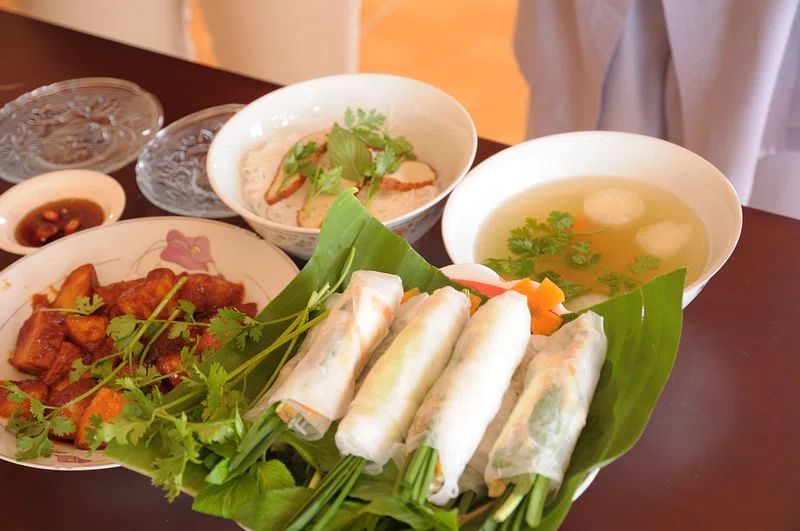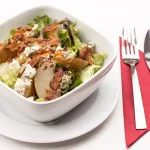The Best Fluffy Pancakes recipe you will fall in love with. Full of tips and tricks to help you make the best pancakes.
When the weather warms up or you’re craving something light, fresh, and flavorful, spring rolls are the perfect go-to. These refreshing Asian bites are easy to make at home and packed with crisp vegetables, herbs, and your choice of protein—all wrapped in delicate rice paper. Whether you’re new to Asian food recipes or just looking for a healthy and satisfying snack, spring rolls offer a versatile and delicious option.
Inspired by Vietnamese and Thai cuisine, homemade spring rolls are not only simple to prepare, but also a fun way to enjoy a hands-on cooking experience. You can easily customize them with ingredients like shrimp, tofu, or chicken, along with vibrant herbs like mint, cilantro, and basil. Plus, no spring roll is complete without a tasty dipping sauce, from classic peanut hoisin to spicy chili blends.
In this post, we’ll guide you through everything you need to know to create easy and healthy spring rolls at home—from ingredients and techniques to flavorful variations and serving tips.
What Are Spring Rolls and Why Are They So Refreshing?
Spring rolls are a beloved dish in many parts of Asia, particularly in Vietnamese and Thai cuisine, where they are known for their light, fresh, and flavorful ingredients. Unlike their deep-fried counterparts often found in Chinese takeout menus, fresh spring rolls (sometimes called salad rolls or summer rolls) are served cold or at room temperature and wrapped in delicate rice paper.

These rolls are typically filled with a combination of crisp vegetables, such as carrots, cucumber, lettuce, and red cabbage, along with vermicelli noodles, protein options like shrimp, tofu, or grilled chicken, and plenty of fresh herbs like mint, cilantro, and Thai basil. The ingredients are rolled tightly to create a neat, hand-held bite that’s bursting with flavor and texture.
What makes spring rolls so refreshing is their unique combination of cool, crunchy vegetables and aromatic herbs. Each bite is hydrating, crisp, and clean—perfect for warmer seasons or as a palate cleanser alongside spicier dishes. They’re also incredibly customizable and can be made vegetarian, vegan, or gluten-free depending on your dietary needs.
Another refreshing element is the lightness of the rice paper, which holds everything together without the heaviness of bread or fried batter. Paired with a cool dipping sauce like tangy peanut hoisin or zesty lime chili, spring rolls offer a balance of bold and delicate flavors that make them both satisfying and invigorating.
Whether you serve them as a starter, snack, or part of a main meal, spring rolls bring a sense of freshness and simplicity that’s hard to beat.
Key Ingredients for the Best Homemade Spring Rolls
Creating the perfect homemade spring rolls starts with selecting fresh, high-quality ingredients that bring a balance of texture, flavor, and nutrition. Here’s a breakdown of the essential components you’ll need to make spring rolls that are as delicious as they are refreshing.
1. Spring Roll Wrappers or Rice Paper
The foundation of any fresh spring roll is the wrapper, which is traditionally made from rice paper. These thin, translucent sheets are made from rice flour and water, offering a light, chewy texture that holds the filling together without overpowering it. Rice paper is naturally gluten-free and dissolves slightly when softened in water, allowing for easy rolling.
When choosing rice paper, look for round sheets that are flexible enough to roll without tearing but sturdy enough to hold your ingredients securely.
2. Protein Options: Shrimp, Tofu, or Chicken
Adding a protein boosts the nutritional value and makes spring rolls more filling. Common choices include:
- Shrimp: Lightly boiled or steamed shrimp add a sweet and slightly briny flavor that pairs perfectly with fresh veggies.
- Tofu: For a vegetarian or vegan option, firm tofu works great, especially when marinated or lightly pan-fried for added flavor and texture.
- Chicken: Grilled or poached chicken breast adds a mild, lean protein that’s easy to digest and complements the fresh herbs and vegetables.
You can also mix and match or leave the rolls purely vegetarian based on your preference.
3. Fresh Vegetables: Carrots, Cucumbers, Lettuce, and Red Cabbage
The hallmark of refreshing spring rolls is the crispness and crunch from fresh vegetables. Popular veggie choices include:
- Carrots: Julienned carrots add sweetness and vibrant color.
- Cucumbers: Thinly sliced cucumber brings a cool, hydrating crunch.
- Lettuce: Butter lettuce or romaine provide a soft but crisp texture that acts as a base layer inside the roll.
- Red cabbage: Adds a beautiful purple hue and a slight earthiness, along with a satisfying crunch.
Using a variety of vegetables not only enhances texture but also makes your spring rolls colorful and visually appealing.
4. Fresh Herbs and Extras: Cilantro, Mint, Basil, and Vermicelli Noodles
The fresh herbs are what truly elevate spring rolls and give them their signature aroma and burst of flavor:
- Cilantro: Offers a bright, citrusy note.
- Mint: Adds cooling freshness that complements the veggies.
- Thai basil: Provides a sweet, slightly peppery flavor unique to Southeast Asian cooking.
In addition, vermicelli rice noodles are often added for a soft, delicate texture that balances the crunchiness of the vegetables.
5. Optional Add-Ins and Flavor Enhancers
To make your spring rolls even more flavorful, consider adding thin slices of avocado for creaminess, chopped peanuts for crunch, or even a few slices of fresh chili if you like a bit of heat.
Step-by-Step Guide: How to Make Fresh Spring Rolls at Home
Making fresh spring rolls at home might seem intimidating at first, but with a little practice and the right technique, it’s actually quite simple and fun! Follow these steps to create perfectly wrapped, delicious spring rolls every time.
1. Prepare Your Ingredients
Before you start rolling, gather and prep all your fillings:
Wash and dry your fresh herbs and vegetables thoroughly to avoid soggy rolls. Julienne or thinly slice vegetables like carrots, cucumber, and red cabbage to ensure they fit neatly inside the roll. For precise slicing, a sharp, reliable knife like the Ninja NeverDull Premium Stainless Steel Knife makes all the difference. Cook proteins such as shrimp, chicken, or tofu, and slice them into thin strips for easy rolling. Cook vermicelli noodles according to package instructions, then rinse under cold water to cool and prevent sticking.
Organizing your ingredients in small bowls or on a large plate will make the assembly process smooth and efficient.
2. Soften the Rice Paper Wrappers
Rice paper wrappers need to be softened just right — too dry and they’ll crack, too wet and they’ll tear. Here’s how:
- Fill a large shallow dish or pie plate with warm water (not hot).
- Dip one rice paper wrapper into the water for about 5-10 seconds until it becomes soft and pliable but still slightly firm (it will continue to soften once out of the water).
- Lay the softened wrapper flat on a clean, damp kitchen towel or cutting board.
3. Assemble the Spring Rolls
This step is where the magic happens:
- Place a few leaves of lettuce in the center of the wrapper as a base to keep other ingredients from sticking to the rice paper.
- Add a small handful of vermicelli noodles on top of the lettuce.
- Arrange your sliced vegetables and proteins evenly but not too heavily — this helps with easier rolling.
- Add fresh herbs like mint, basil, and cilantro last, as their flavor is key to the freshness of the roll.
4. Roll Them Up
Rolling properly ensures your spring rolls stay intact and look neat:
- Fold the bottom edge of the wrapper up over the filling.
- Fold in the sides toward the center, creating a sealed pocket.
- Continue rolling upward tightly but gently until the roll is fully wrapped.
- Repeat with the remaining wrappers and fillings.
5. Storage and Serving Tips
- Serve your spring rolls immediately for the freshest texture and taste.
- If you need to store them, cover them tightly with a damp paper towel and wrap in plastic wrap to keep the rice paper moist. Refrigerate and consume within 24 hours.
- Pair your spring rolls with a delicious dipping sauce like peanut hoisin or spicy chili sauce for the full experience.
Dipping Sauces That Pair Perfectly with Spring Rolls
No spring roll experience is complete without a delicious dipping sauce to complement its fresh and crisp flavors. The right sauce adds a burst of savory, sweet, spicy, or tangy notes that elevate every bite. Here are some classic and easy-to-make dipping sauces that pair perfectly with your homemade spring rolls.
1. Classic Hoisin-Peanut Dipping Sauce
This rich, slightly sweet sauce is a favorite in Vietnamese cuisine and a natural match for spring rolls.
- Ingredients: hoisin sauce, peanut butter, soy sauce, garlic, lime juice, water, and crushed peanuts.
- Flavor profile: creamy, nutty, sweet, with a hint of tanginess.
- How to serve: Mix the ingredients until smooth and sprinkle with crushed peanuts for added texture. This sauce pairs especially well with shrimp and chicken spring rolls.
2. Spicy Thai Chili Sauce
For those who love a kick, a spicy chili sauce offers a perfect balance of heat and sweetness.
- Ingredients: Thai sweet chili sauce, fresh lime juice, fish sauce, garlic, and chopped fresh chili (optional for extra heat).
- Flavor profile: sweet, spicy, tangy, and slightly salty.
- How to serve: Stir all ingredients together and adjust the chili level to your taste. This sauce is excellent for vegetarian rolls or those with tofu.
3. Tangy Soy Sauce and Rice Vinegar Dip
A simple, light sauce that enhances the fresh ingredients without overpowering them.
- Ingredients: soy sauce, rice vinegar, a pinch of sugar, minced garlic, and sliced green onions.
- Flavor profile: salty, tangy, with a subtle sweetness.
- How to serve: Combine ingredients and serve chilled or at room temperature. This dip works well when you want something less creamy and more refreshing.
4. Customizing Your Dipping Sauces
You can easily tweak any dipping sauce to suit your personal preferences:
- Add a splash of sesame oil for a nutty aroma.
- Incorporate fresh herbs like cilantro or basil for extra freshness.
- Use lime juice or zest to brighten flavors.
- Mix in a bit of honey or brown sugar if you prefer a sweeter sauce.
Tips for Serving
- Serve your dipping sauces in small bowls alongside the spring rolls to encourage dipping and sharing.
- Offer a few different sauces to cater to diverse taste preferences.
- Garnish sauces with crushed peanuts, sesame seeds, or chopped fresh herbs for visual appeal and added flavor.
Spring Rolls Variations and Asian-Inspired Serving Ideas
One of the best things about spring rolls is how versatile they are. While the classic Vietnamese fresh spring roll is well-loved, you can easily customize and experiment with different ingredients and presentation styles to suit your taste, dietary preferences, and the occasion. Here are some popular variations and creative serving ideas to inspire your next spring roll experience.
1. Protein Variations: Beyond Shrimp and Chicken
While shrimp and chicken are common proteins in fresh spring rolls, you can switch things up:
- Tofu or Tempeh: Perfect for vegetarians and vegans, marinated and grilled or pan-fried tofu adds a satisfying texture and flavor. Tempeh also brings a nutty richness.
- Pork or Beef: Thinly sliced grilled pork or beef can add a hearty, savory element reminiscent of some traditional Asian recipes.
- Seafood Mix: Combine shrimp with crab meat or even smoked salmon for a luxurious twist.
2. Vegetarian and Vegan Spring Rolls
Loaded with crunchy vegetables, fresh herbs, and noodles, vegetarian spring rolls are naturally light and nutritious. Consider:
- Adding avocado slices for creaminess.
- Using a variety of colorful veggies such as bell peppers, bean sprouts, and julienned zucchini.
- Including mango or pineapple slices for a sweet, tropical surprise.
3. Fusion and Flavor Twists
Get creative by blending different cuisines or flavors into your spring rolls:
- Mexican-Inspired: Add ingredients like black beans, corn, avocado, and a spicy chipotle dipping sauce for a fun fusion.
- Mediterranean Style: Incorporate hummus, cucumber, olives, and feta cheese with a lemon-tahini dip.
- Korean Flare: Use bulgogi beef or kimchi with a gochujang-based sauce for a spicy punch.
4. Serving Ideas: Presentation and Pairings
How you serve spring rolls can turn a simple snack into an elegant appetizer or a satisfying meal:
Party Platters: Arrange rolls with colorful dipping sauces and garnishes like chopped peanuts, sesame seeds, and fresh lime wedges for an inviting spread.
As an Appetizer: Serve several mini spring rolls on a decorative platter with a variety of dipping sauces for guests to try.
Spring Roll Bowls: For a deconstructed option, layer all ingredients like noodles, veggies, protein, and herbs in a bowl with dressing or sauce on top.
With Soup or Salad: Pair fresh spring rolls with a light Asian-inspired soup such as miso or pho, or alongside a crunchy Asian slaw for a balanced meal. For more delicious Asian salad ideas that complement spring rolls perfectly, check out these Unbelievably Delicious Asian Salad Recipes You Need Right Now.
5. Tips for Keeping Spring Rolls Fresh When Serving
- Keep rice papers covered with a damp towel to prevent drying out.
- Store rolls in a single layer if refrigerating; stacking can cause tearing.
- Prepare dipping sauces ahead of time and serve chilled or at room temperature.
By exploring these variations and serving ideas, you can enjoy spring rolls in countless delicious ways—whether you prefer traditional flavors or want to experiment with new, exciting combinations. Spring rolls are truly a canvas for creativity that celebrates freshness and flavor.





